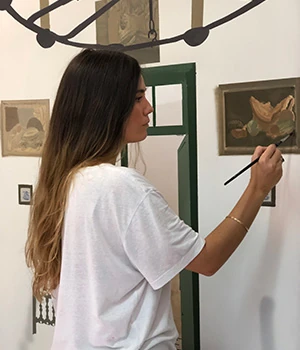
BIO
Julia Santa Olalla (Granada, 1985) studied at the Alonso Cano Faculty of Fine Arts of the University of Granada. She trained with other artists there whilst learning the profession by attending courses, exhibitions, and painting contests. Santa Olalla has presented different projects in individual exhibitions, the most notable of which are ‘Between the Hole and the Wall’ (Espacio Iniciarte, Córdoba, 2020); ‘The Rabbit Fountain’ (Di Gallery, Seville, 2021) and ‘Sodstory’ (Condes de Gabia Palace, Granada, 2019).
She has also joined group exhibitions, amongst which the more remarkable ones are ‘The Blue Words’ (Trafalgar 45, Barcelona, 2021), ‘Homemade’ (Di gallery, Seville, 2020) and ‘Homeless’ (Void Projects, Miami, 2017).
She has also been awarded painting prizes such as ‘Manuel Ángeles Ortiz’ contest arranged by The University of Jaén in 2017, the ‘Timoteo Pérez Rubio’ eighteenth edition prize, or the ‘Ramón Portillo’ amongst others.
Likewise, he has been granted scholarships such as ‘FACBA 22’, ‘Start’ (2020) and ‘Young Plastic Artists’ of the Diputación de Granada in 2018. On the other hand, she has exhibited in ARCO Madrid 2021 with ‘Galería T20’ (Murcia) and the 29th edition of ‘Estampa’. Her artworks are held in collections such as the Sorigué Foundation, Agua de Granada, or the University of Jaén.
ARTWORK
Julia Santa Olalla represents disturbing images, interwoven with something hidden. She shows indefinite starting and ending events. Narrative ellipsis takes importance in montage and what is blocked to the sight through the pictorial. This fact does not resolve the images but instead poisons them with uncertainty. Santa Olalla delves into the ordinary. That zoom-in increases the perception of what surrounds us, albeit intimate or strange.
This search generates disturbance and enigma. The wonderful is equivalent to the poeticization of reality and the revelation of something contained in the day-to-day. Its narrative impulse is a minimalist economy where all detail is in the manifestation of the painting. This happens through different degrees of iconicity and by showing the process off. Santa Olalla leaves the traces of the paint. She does not represent the thing but the matter’s energy. It is a thorough resource deployment applying a cold strategy that grants the suitable space to the accidental, avoiding conflicts and corrections to achieve a finishing that provides her work with sophistication.
Santa Olalla does not cease talking to us and reflecting on the painting itself and its narrative potential. At the same time, she questions us about the evocative capacity of the visual and the responsibility we share when interpreting our reality in the face of ambiguity and indeterminacy.


